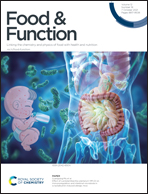Foliar application of glycinebetaine and Zn fertilizer improves both the apparent and functional qualities of albino tea [Camellia sinensis (L.) O. Kuntze]†
Abstract
With Zn deficiency increasing in the global population, functional plant food (including tea) can help to fill the nutrition gap that the main crops cannot meet. Glycinebetaine (GB), an important bioactive substance with a wide range of natural sources, has received limited attention towards its effects on Zn biofortification and the quality of tea. The Zn enrichment and metabolite responses of albino tea [cv. White leaf No. 1 (WL-1)] to the foliar application of GB, Zn, and their combination (Zn + GB) were investigated in a field experiment. The result indicated that the 100-buds weight, total N, Zn, Thea, and total amino acid content in the young leaves of WL-1 with Zn2 + GB2 treatment were significantly increased, whereas the Chla contents were decreased (p < 0.05). The total catechins and CAF contents of Zn2 + GB2 treatment were lower than those of other treatments, with significance (p < 0.05). Multivariate analysis and general quantitative analysis returned complementary results, revealing that Zn2 + GB2 treatment was better for the apparent and functional quality of WL-1. The more theanine and Zn, limited chlorophyll, catechin, and caffeine contributed to the quality improvement, as well as to maintaining the leaf albinistic characteristics, inhibiting astringency and bitterness, exerting flavor and umami, and improving the ultimate beneficial functions. The combined application of Zn and GB is a promising practice for Zn biofortification and for the quality improvement of tea, with spraying 750 L ha−1 of 2.0 g L−1 Zn fertilizer and 3.2 g L−1 GB mixture recommended.
![Graphical abstract: Foliar application of glycinebetaine and Zn fertilizer improves both the apparent and functional qualities of albino tea [Camellia sinensis (L.) O. Kuntze]](/en/Image/Get?imageInfo.ImageType=GA&imageInfo.ImageIdentifier.ManuscriptID=D1FO01398J&imageInfo.ImageIdentifier.Year=2021)


 Please wait while we load your content...
Please wait while we load your content...